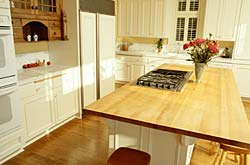Green Kitchens Use the 3 R's: Reduce, Reuse, Recycle
See if We Have Top-Rated
Home Remodelers in Your Area

No other area in the home is more costly than a kitchen. They're one of the largest rooms in the home, and if not, we want them to be bigger. The materials we use to remodel them are not only expensive, but also wasteful, high-maintenance, and inefficient. And most of the appliances installed in this space sap a lot of energy. Of course, this is the place where you cook, eat, and entertain, so it makes sense your kitchen will use the most energy. Plus, you want it be extravagant, warm, and welcoming. But it doesn't make sense for one family to suck up all those resources. This is why green kitchen design has become such a popular trend: it increases environmental efficiency without sacrificing luxury.
Be Energy Efficient
The biggest energy waste comes from oversized and inefficient appliances. Do you need such a big refrigerator? Sure it's always overflowing, but clean it out one day and you may find you've been misusing a lot of space. And do you need that industrial-sized microwave to heat up your TV dinners? Does your dishwasher have to hold an entire pantry of plates? Think about all that energy and water waste, which not only effects the environment but your utility bills as well. Here are some ways to help reduce your use:
Get Downsized: The first step is getting rid of the energy-eaters and buying smaller appliances that require less energy. Also, downsizing certain appliances forces you to become more conscious of unnecessary hoarding and pointless clutter.
Energy Star: Always buy Energy Star rated products that have been approved by the government for optimal energy efficiency, which can save on money and waste. And don't forget this also includes low-e windows with extra insulation and solar shading.
Natural Lighting: Incandescent bulbs are expensive, burn out quickly, and use up lots of energy. Instead, invest in skylights, dormers, or picture windows for daylighting. Or buy compact fluorescent light bulbs which last a lot longer and require less electricity.
New Products: Everyday new energy-efficient appliances hit the market. Invest in an induction cooktop, which is much more effective than gas or radiant models by getting hotter faster while using less power. Or buy a dish-drawer washer: a compact dishwasher that imitates the look of a single drawer.
Make your kitchen more efficient! Use this link for a green
Kitchen Remodel
Alternate Surface Areas
Green kitchens don't just deal with energy issues; they also deal with the materials the room is built out of. Traditional counters, cabinets, and flooring are typically high-maintenance: they're expensive and need a lot of attention. Therefore it may be time to alternate your surfaces areas with stronger alternatives: eco-friendly by-products.
Flooring: Hardwood floors are great, but they cost a lot and are hard on the environment. Instead, use bamboo flooring: it's cheaper and a renewable resource. Also, don't forget about cork floors and recycled glass-tiles, which can give any room a chic appearance.
Counters: Marble, granite, and other natural products can look wonderful, but they need a lot of care and are expensive. Instead, choose other natural routes. Stainless steel looks modern and requires little maintenance. Also, recycled glass, concrete, and even recycled paper products are available for installation.
Cabinets: Instead of wood or particle board, use more eco-conscious materials such as strawboard or wheatboard, which are just as sturdy but are natural plant byproducts.
Non-Toxic: Removing toxins from a space is an important element of green kitchen design. So while building these new surfaces areas, it's important to use non-toxic glues, finishes, and paints. Plus, when cleaning these surfaces, always use organic products.
Less Litter, More Money
Though green kitchens cost more initially, due to their overall efficiency, they will save you money over time. Plus it doesn't have to be a complete transformation. By just using one green kitchen design tip from above, you'll be on your way to a more effective remodel. Even the little things add up to big savings. Just for starters, here are a few last green kitchen tips to keep in mind:
Reuse: Instead of paper plates and napkins, use cloth napkins and reusable plates to help cut down on waste. Also, investing in thermal cookware (which heats up quickly and maintains its temperature) is a great way to save additional energy.
Recycle: Always make room for recycling bins in the home. And when getting rid of the old appliances, make sure somebody else can use them: give the microwave to charity or sell the fridge for extra cash.
Reduce: If you're thinking about buying new, eco-friendly materials for your green kitchen, make sure you buy locally, instead of globally. Paying shipping costs hurts your budget and wasting all those fossil fuels via transportation isn't very helpful.
If you enjoyed this article, check out our free Kitchen Remodeling Guide, which features expert advice, design & material comparisons, and custom price estimates for your remodeling project.

